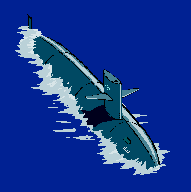|
Submarines

Today, the most feared
fighting ships are not surface ships but nuclear submarines.
These craft can remain undetected in any of the Earth's oceans,
and can carry enough nuclear missiles to devastate more than a
hundred cities.
Submarines
submerge (sink beneath the water) by flooding ballast tanks with
water, and surface by emptying them using compressed air.
Like ordinary ships, they use a propeller for propulsion. The
propeller is driven in conventional submarines by a diesel engine
on the surface, and by an electric motor underwater. Nuclear
submarines are driven by steam turbines using nuclear energy.
 |
A submarine is
steered through the water by means of a vertical rudder and
horizontal fins, called diving planes or hydroplanes.
There is one set of planes in the cross-shaped "tail" at the
stern, and one on each side near the bow or on the
projecting tower, or sail. The sail acts as a
navigation bridge on the surface. It also houses one
or more periscopes and a snorkel tube. The periscopes
enable the crew to see above the surface of the water while
remaining submerged. |
Nuclear-powered
submarines are big. Submarines owned by the Soviet Union's
Typhoon class are 170 m (560 ft.) long. The submarine craft
used by civilians, called submersibles, are much smaller.
They are often used for ocean research and for supporting offshore oil
production.
|